- Line 6 POD HD500
- Boss GT-100
- TC Electronic Nova System
TC Electronic unit Nova System
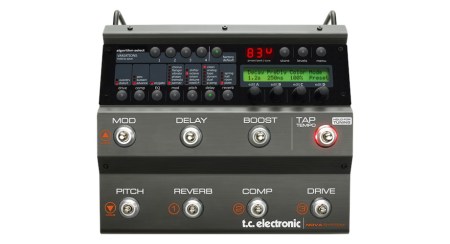
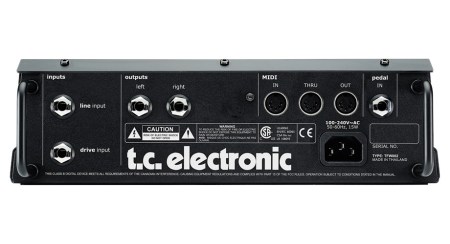
Line 6 HD500

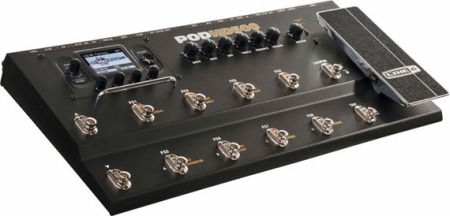

Boss GT-100
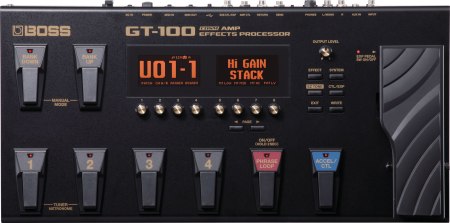








I bought both of these books in the past year. Both are well worth having if you are interested in building your own electric guitars. Between them they cover more or less everything you need for designing and building a guitar, except of course your imagination which you have to supply yourself. An electric guitar is not all that hard to build, especially if you use off the shelf parts. It is quite possible to build something that is unique and very playable without breaking the bank.
Make Your Own Electric Guitar by Melvyn Hiscock
Melvyn Hiscock’s book is a great reference book for all aspects of guitar-building and repairing. It is an excellent collection of useful information into one place, both reference information (such as tables of scale length and fret spacing) and techniques (such as how to make a neck). My copy is well-thumbed…
Guitar Electronics for Musicians (Guitar Reference) by Donald Brosnac
Donald Brosnac’s book is a similar reference work but specifically for guitar electrics and electronics. Lots of tremendously useful data in this one as well. It goes into the difference between various types of pickups, what makes them sound different, what parts of circuits do etc.
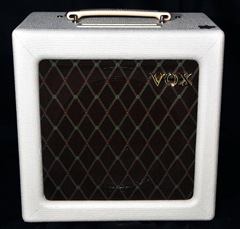 Small is beautiful! This is a lovely little amplifier which both looks and sounds great. I was looking for something I could use at home to play guitar, because my other amps are all very loud. I wanted it to be a small (really small – maybe less than 1 watt) valve amp, as I really don’t much like solid state amps with digital modelling. If you look around, you find that there are a lot of small amps on the market for use in the studio or home setting. Epiphone do the Valve Junior in Head and Combo versions, Harley Benton (available from Thomann) do exactly the same thing and call it the GA5 – apparently from the same factory but with a different livery. There are a couple of Blackheart mini-amps (the BH1H and the BH5H) some from Orange, a great mini-stack from Blackstar, and a whole long list of boutique amps made by renegade monks who have returned to their first allegiance and secreted themselves in dark places of the earth to devoutly develop the perfect use for the EL84 thermionic valve. There is no way I could try them all, so I just tried what was available at Gig Gear in Harlow.
Small is beautiful! This is a lovely little amplifier which both looks and sounds great. I was looking for something I could use at home to play guitar, because my other amps are all very loud. I wanted it to be a small (really small – maybe less than 1 watt) valve amp, as I really don’t much like solid state amps with digital modelling. If you look around, you find that there are a lot of small amps on the market for use in the studio or home setting. Epiphone do the Valve Junior in Head and Combo versions, Harley Benton (available from Thomann) do exactly the same thing and call it the GA5 – apparently from the same factory but with a different livery. There are a couple of Blackheart mini-amps (the BH1H and the BH5H) some from Orange, a great mini-stack from Blackstar, and a whole long list of boutique amps made by renegade monks who have returned to their first allegiance and secreted themselves in dark places of the earth to devoutly develop the perfect use for the EL84 thermionic valve. There is no way I could try them all, so I just tried what was available at Gig Gear in Harlow.
Young guitarists such as I was 25 years ago often think that an amplifier needs a high wattage output rating to be loud. 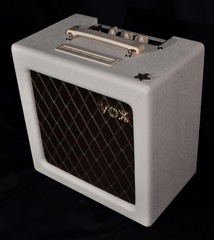 Not so, Grasshopper. a 5W amplifier can fill your ears to bursting with the right speaker in the right room. The placement of an amplifier, and the area and efficiency of the output transducer (loudspeaker) is very much a part of how an amplifier performs. Even a 1W amplifier can be SO LOUD YOU HAVE TO SHOUT. Something between 100mw and 250mw is, with the right speaker, loud enough to practice at home and will get a ‘driven’ sound at low enough volumes. This can be pretty useful in the studio as well. Another approach to keeping the volume low while still getting the tone is to use a power soak on the output of the amp. The Peavey Windsor Studio has one of these, and it works very well indeed. This is a great little amp and I was sorely tempted to buy it, but it’s a bit bigger than what I had in mind.
Not so, Grasshopper. a 5W amplifier can fill your ears to bursting with the right speaker in the right room. The placement of an amplifier, and the area and efficiency of the output transducer (loudspeaker) is very much a part of how an amplifier performs. Even a 1W amplifier can be SO LOUD YOU HAVE TO SHOUT. Something between 100mw and 250mw is, with the right speaker, loud enough to practice at home and will get a ‘driven’ sound at low enough volumes. This can be pretty useful in the studio as well. Another approach to keeping the volume low while still getting the tone is to use a power soak on the output of the amp. The Peavey Windsor Studio has one of these, and it works very well indeed. This is a great little amp and I was sorely tempted to buy it, but it’s a bit bigger than what I had in mind.
The two cheap options I looked at were the Epiphone Valve Junior and the Vox AC4TV, both in combo format. There is one very obvious difference between the two, and that is the switchable output power on the Vox. It can switch between quarter watt, one watt and four  watts – quiet, medium and loud. I think the switch actually does something with resistors but I haven’t yet looked inside to see.
watts – quiet, medium and loud. I think the switch actually does something with resistors but I haven’t yet looked inside to see.
The Epiphone is more crudely made, but is ideal for playing around with amp electronics if that is your interest. There are loads of EVJ ‘modding’ sites around on the internet, and some people will mod your amp for you for a fee (that’s cheating though). Health warning: don’t start pulling a valve amp to pieces unless you know what you are doing and have researched it thoroughly. Valve amps have high voltages in them, and large charges are often found residually in the smoothing capacitors on power supplies. You can get a hell of a shock off even a small amp.
The little Vox is perfect for my use. It looks very nice with the cream covering and a design which is based on the original ‘TV’ amps Vox built in the 50s. That retro look is maintiained through to the control panel which has cream chicken-head knobs and looks just like a 50 year old amp. It can be run quite quietly and used in a room with a closed door without really annoying the rest of the household. It sounds very good with a number of different guitars and can be overdriven etc in the same way as a bigger amp. It is very well built (in Vietnam), and the tone control is actually rather useful. It has two valves in a Class A configuration – a 12AX7 and a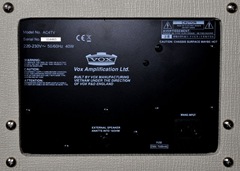 n EL84. You can plug an extension speaker into it, something which I will try later as I want to see how it sounds with a bigger speaker. Internally it has a Celestion VX10 ten inch speaker which is pretty good, but I want to try it with a twelve inch speaker or even a 4×10 or 4×12 cab. It is a very simple amp, but does the job I ask of it extremely well.
n EL84. You can plug an extension speaker into it, something which I will try later as I want to see how it sounds with a bigger speaker. Internally it has a Celestion VX10 ten inch speaker which is pretty good, but I want to try it with a twelve inch speaker or even a 4×10 or 4×12 cab. It is a very simple amp, but does the job I ask of it extremely well.
I will probably get the EVJ as well so I can take it apart and build a Frankenstein-amp from the parts.
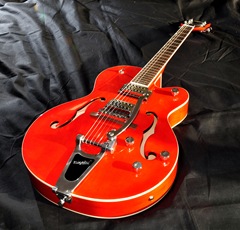 The Gretsch G6120 and the Gretsch Country Gentleman are the classic rockabilly guitars, and have been used by many different people. They are very expensive though, starting at 1500 pounds and going on up in leaps and bounds. An original 50s Gretsch costs many thousands. One of the most well-known Grestch-playing guitarists is Brian Setzer of the Stray Cats and the Brian Setzer Orchestra. Pete Townshend used a Grestch G6120 on the studio recordings of Quadrophenia, and you can see one in pictures of his line-up quite a lot. It has a very respectable heritage.
The Gretsch G6120 and the Gretsch Country Gentleman are the classic rockabilly guitars, and have been used by many different people. They are very expensive though, starting at 1500 pounds and going on up in leaps and bounds. An original 50s Gretsch costs many thousands. One of the most well-known Grestch-playing guitarists is Brian Setzer of the Stray Cats and the Brian Setzer Orchestra. Pete Townshend used a Grestch G6120 on the studio recordings of Quadrophenia, and you can see one in pictures of his line-up quite a lot. It has a very respectable heritage.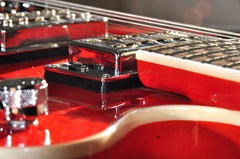
For those who cannot afford to pay the price of a small car for a guitar, Gretsch have produced a budget line, the G5xxx Electromatic guitars. For just under 500 quid, you can get a G5120 which looks at first sight to be identical to a G6120, but at 25-30% of the price. Obviously Gretsch have to cut some corners to produce a much cheaper guitar, so they manufacture the Electromatic series in Korea to cut down on labour costs. However, there are quite a few other corners cut as well. I played this guitar without an amp in a music shop, and thought it played really nicely – it has a slick and playable neck and the full-size hollow body is solid and comfortable to wear with a strap or just holding the guitar on your knee when sitting down. When I got it home I eagerly plugged it into my Fender Deville and was hugely disappointed.
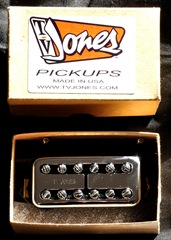 The pickups on the G5120 are humbucking pickups (often referred to as Gretschbuckers), and nothing special at all. They lack tone and definition and really do not complement this basically OK guitar. This is definitely not just a cheap G6120, it will need some work to make it fun and interesting to play. I did some research and discovered that the top of the line Gretsch’s now use TV Jones pickups, so I invested another 100 quid in the bridge version of these (TV Classic, English mount 2) to see if it improves things. I haven’t had time to install it yet, but will do so soon.
The pickups on the G5120 are humbucking pickups (often referred to as Gretschbuckers), and nothing special at all. They lack tone and definition and really do not complement this basically OK guitar. This is definitely not just a cheap G6120, it will need some work to make it fun and interesting to play. I did some research and discovered that the top of the line Gretsch’s now use TV Jones pickups, so I invested another 100 quid in the bridge version of these (TV Classic, English mount 2) to see if it improves things. I haven’t had time to install it yet, but will do so soon.
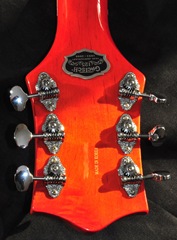 Having been so disappointed in the sound, I was not surprised to find some other things to deplore. The machine heads are cheap crap, and don’t hold the guitar in tune even if you don’t use the Bigsby. They are also not accurate and seem to have some play in them so it is difficult to get the guitar in tune to start with. I will have to replace these as well (another 50 quid or so). The bridge is also a bit pathetic. It leans slightly forward towards the pickup, and the bottom is not contoured properly to fit the top of the guitar. It has no locating pins and therefore needs careful
Having been so disappointed in the sound, I was not surprised to find some other things to deplore. The machine heads are cheap crap, and don’t hold the guitar in tune even if you don’t use the Bigsby. They are also not accurate and seem to have some play in them so it is difficult to get the guitar in tune to start with. I will have to replace these as well (another 50 quid or so). The bridge is also a bit pathetic. It leans slightly forward towards the pickup, and the bottom is not contoured properly to fit the top of the guitar. It has no locating pins and therefore needs careful  positioning every time you re-string the guitar. I shall probably need to replace this as well (another 50 quid?). For some reason, the guitar is supplied with a little bit of packing foam separating the bridge from the body. You have to pretty much unstring the guitar to get rid of it, and then reposition the bridge exactly as was while you re-string it (or re-do the intonation yourself anyway.
positioning every time you re-string the guitar. I shall probably need to replace this as well (another 50 quid?). For some reason, the guitar is supplied with a little bit of packing foam separating the bridge from the body. You have to pretty much unstring the guitar to get rid of it, and then reposition the bridge exactly as was while you re-string it (or re-do the intonation yourself anyway. 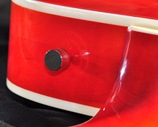 Gretsch supply odd strap buttons as well. They seem to be a primitive sort of locking strap button, in that you can unscrew them from the body and then attach a strap by screwing the button back in through the strap hole. I don’t like these either and will probably replace them with Marvel straplocks which I do like (another tenner).
Gretsch supply odd strap buttons as well. They seem to be a primitive sort of locking strap button, in that you can unscrew them from the body and then attach a strap by screwing the button back in through the strap hole. I don’t like these either and will probably replace them with Marvel straplocks which I do like (another tenner).
Finally, the electrics are a bit counter intuitive. I plugged the guitar into an MXR Dyna-Comp pedal, and when it is switched out the guitar has a nasty dull grungy humbucking sound. When the compressor is switched in it goes quieter and much cleaner. Exactly the same settings with a Strat give a huge burst of energy when the Dyna-comp is kicked into play. Maybe it’s just me. I need to figure out what each of the knobs is supposed to do and take a look at whether or not it can be improved when I install the new pickup.
So, a great looking guitar, but out of the box a disappointment when plugged in. I will need to spend another 200-300 quid on it to make it really playable (new pickups, new bridge, new straplocks, new machine heads). It was already a bit pricey for a ‘budget’ guitar, and this just makes it rather expensive (around 750 quid) for what it is. I hear that the Epiphone Wildkat does a better job by far, and costs about 350 pounds. I haven’t yet tried one so I can’t venture an opinion. I would also definitely like to try the new Epiphone Emperor Swingster as an alternative. I wouldn’t buy another Electromatic – I would rather save up a lot more money and get a genuine Gretsch G6120, and then only after rigorously testing it through an amplifier and inspecting the build.
Visit Gretsch.com for more information
A very useful Gretsch player community can be found in a forum at Gretsch-talk.com
As everything retro is in many people’s eyes better than everything 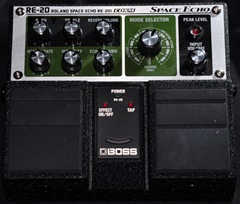 modern, manufacturers have been driven to make modern versions of older devices, instruments and amplifiers in order to capitalise on this enthusiasm for the past. Actually, some of the older kit was designed and built by enthusiasts rather than just engineers (though some of the enthusiasts were engineers as well as being musicians). This gave a certain amount of musicality and artistry to the technology, which is often lacking in these days of hard capitalism and charmless corporate products.
modern, manufacturers have been driven to make modern versions of older devices, instruments and amplifiers in order to capitalise on this enthusiasm for the past. Actually, some of the older kit was designed and built by enthusiasts rather than just engineers (though some of the enthusiasts were engineers as well as being musicians). This gave a certain amount of musicality and artistry to the technology, which is often lacking in these days of hard capitalism and charmless corporate products.
The RE-20 pedal is one of those voyages back into the past to a grand old Daddy of retro FX units, the Roland RE-201 Space Echo. I have an original RE-201 in my studio, so am able to compare the two, albeit in a highly subjective way as with everything musical (one man’s cacophony is another man’s symphony). 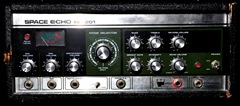 The old RE-201, for those who don’t know, is a tape echo device with a spring-line reverb unit built in. It has a number of playback heads, and the tape speed can be varied. This allows everything from rapid slap-back echo to long psychedelic repeating phrase type effects. It has the typical decay pattern and sound of tape echo and can feedback on itself to help create wonderful or awful sounds as your taste dictates. It deserves classic status as it really did the job well, and appears on probably thousands of recordings, and is still being used. Boss
The old RE-201, for those who don’t know, is a tape echo device with a spring-line reverb unit built in. It has a number of playback heads, and the tape speed can be varied. This allows everything from rapid slap-back echo to long psychedelic repeating phrase type effects. It has the typical decay pattern and sound of tape echo and can feedback on itself to help create wonderful or awful sounds as your taste dictates. It deserves classic status as it really did the job well, and appears on probably thousands of recordings, and is still being used. Boss 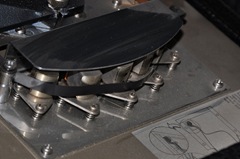 have used their COSM modelling system to capture pretty much every nuance of what an RE-201 does, and squash it into a double-size Boss pedal. The front panel is obviously based on that of the RE-201 and they have done their best to make sure the same controls are there and that they do the same things.
have used their COSM modelling system to capture pretty much every nuance of what an RE-201 does, and squash it into a double-size Boss pedal. The front panel is obviously based on that of the RE-201 and they have done their best to make sure the same controls are there and that they do the same things.
The RE-20 pedal has a few features that the RE-201 did not. Firstly, you can set the echo rate using ‘tap tempo’ – tapping your foot on the right hand pedal. Personally, I really like this. It also has stereo inputs and outputs and an expression pedal socket.  It doesn’t use tapes which wear out, and it is a lot smaller and lighter, and has footswitches built in. The RE-201 has a three channel mixer to increase the knob count on the front panel. I have never used either of the MIC inputs though. Take the lid off the RE-201 and you see the tape cassette, spare tape envelope and head assembly. Inside the lid is a pink and yellow idiot’s guide to using the Space Echo.
It doesn’t use tapes which wear out, and it is a lot smaller and lighter, and has footswitches built in. The RE-201 has a three channel mixer to increase the knob count on the front panel. I have never used either of the MIC inputs though. Take the lid off the RE-201 and you see the tape cassette, spare tape envelope and head assembly. Inside the lid is a pink and yellow idiot’s guide to using the Space Echo.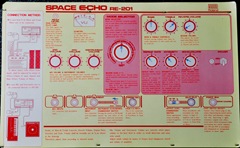
So what does the RE-20 sound like? To my ears it sounds very like the original RE-201 Space Echo. I have tried both of them one after the other, and apart from having to match the outputs to get signal levels correct, I could not really tell the difference. I was a bit afraid that the pedal might sound rather digital, but in fact the modelling is excellent. I have read other reviews that compare this pedal to other echo pedals like the Boss DD-3 which is not a fair comparison. The RE-20 is a very good effort at modelling an early ‘80s analogue tape echo with all the noise and flutter that goes with it. It is not intended as an alternative to a digital delay pedal, and in fact sounds quite different, but still good.
I have only tried the pedal as a guitar effect, and I did read somewhere that there are difficulties with using it as a send effect on a mixing desk, which might inhibit it’s use for dub, something for which it’s older tape-driven relative was justly famous. ON the other hand, someone else said this is rubbish and it can be used perfectly well as a send effect. One day I shall try it and see who is right.
I got this for 33 pounds on eBay, and it arrived in the original box with all leaflets and packaging. It has no real marks of use, and could well have come straight from the shop. It’s a brilliant pedal. I have often been dubious of distortion/fuzz/overdrive pedals, thinking I just liked overdriven valves. However, to get that sound from a valve amplifier, even a fairly small one, you have to drive it quite hard – meaning it will be very loud. Although the mesmerising beauty of my playing no doubt captivates my family and neighbours, it is possible to have too much of a good thing. I therefore cannot turn my amps up high all the time. This pedal does a great job of overdriving the input stage of my amp in such a way as to provide some great crunch that still has good definition.
I first used it in front of my Fender Deville with a Stratocaster. It sounded excellent after a few tweaks. I haven’t tried the distortion setting yet, but as an overdrive this pedal is very good indeed. You can see the settings I used on the right. I patched the pedal into the clean channel on the amp and could switch between clean/twangy and crunchy/powerful. Very nice little pedal, and at the ebay price great value. I think they are about 60 quid new, and are probably worth that much.
Until two weeks ago, I had never heard of Biffy Clyro. Then I noticed a big poster for their new album as I was driving home from work. A week later, I was in my local music shop looking for a red Stratocaster, and I tried a Fender Mexican build Standard. It was OK, but in a mediocre sort of way. I then tried another of the same (but this time a white one) just to see if the red one was a rotten apple. No it wasn’t. I found the Mexican build Standard Strats to be universally disappointing. The necks felt dry and although smooth, as if they had been rubbed down ready for another coat of lacquer that never happened. Although there is little you could point at specifically as being bad, they just felt…mediocre. I have a 1975 Japanese built Strat that is much much better.
The reason I wanted a red Stratocaster is quite simple really – Pete Townshend plays one. His has a Fishman Bridge with a built in piezo transducer and pre-amp. The jack output is stereo with the Piezo on one channel and the normal pickups on the other. There is a stereo guitar cable which goes to a splitter box and from there you can route the two signals any way you like, mixing or processing as you want (or as Pete wants). As a long time Pete Townshend fan, I wanted to try the same setup just because I like his guitar sound. Obviously the colour of the guitar is not important, but I liked the look of the red strat. 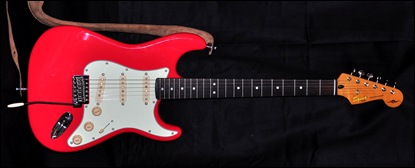
Squier Simon Neil Stratocaster by Fender
Back in the shop, after being disappointed by the Mex Strats, I noticed another red strat high on the wall of guitars, but this time a Squier by Fender model with a funny squiggle on the headstock. That’s when Biffy Clyro was brought to my attention again – apparently the squiggle is a Biffy Clyro log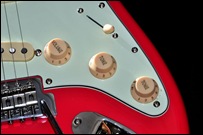 o and Simon Neil is the guitarist. There is another squiggle on the back of the headstock which is Simon Neil’s signature. I still have no idea what Biffy Clyro sound like (I must find out), but their taste in guitars is great! This is a Made In China (MIC) Stratocaster, and it is beautifully made. The neck is lovely, with a very fast, slick feel to it, and no rough corners. The body is nicely finished, and the attention to period detail is brought out in the faint mint greeniness of the scratch plate and the cream coloured knobs. The guitar is based on th
o and Simon Neil is the guitarist. There is another squiggle on the back of the headstock which is Simon Neil’s signature. I still have no idea what Biffy Clyro sound like (I must find out), but their taste in guitars is great! This is a Made In China (MIC) Stratocaster, and it is beautifully made. The neck is lovely, with a very fast, slick feel to it, and no rough corners. The body is nicely finished, and the attention to period detail is brought out in the faint mint greeniness of the scratch plate and the cream coloured knobs. The guitar is based on th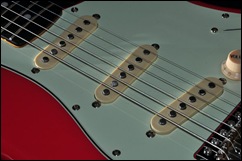 e Squier Classic Vibe series, so I guess the other classic vibe guitars might well be worth a look.
e Squier Classic Vibe series, so I guess the other classic vibe guitars might well be worth a look.
The hardware is surprisingly good. The bridge is OK without being outstanding, and I might need to add a spring or two in the back. The machine heads are excellent – much better than I had been led to expect from a Squier. I think there is a wide range of quality in the Squier catalogue, from very cheap and cheerful with rubbish fittings to very good at the more expensive end. It sounds great t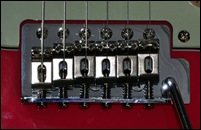 hrough a small Vox AC4TV combo – I was really pleased when I plugged it in and hit the first chord. Lovely vibrant jangly tone with a bit of grunt from the amplifier and good definition. Through an overdrive pedal fronting a Fender Deville it is an absolute joy to play, with excellent sustain and a wide variety of tone to work with.
hrough a small Vox AC4TV combo – I was really pleased when I plugged it in and hit the first chord. Lovely vibrant jangly tone with a bit of grunt from the amplifier and good definition. Through an overdrive pedal fronting a Fender Deville it is an absolute joy to play, with excellent sustain and a wide variety of tone to work with.
The only modification I hav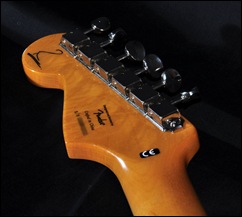 e made to the guitar is to put Marvel straplocks on it.
e made to the guitar is to put Marvel straplocks on it.
I think Fender/Squier has really done well to make this guitar. It certainly rivals some much more expensive guitars and for me provides one of those rare occasions when you get excellent value for money. The Mexican Stratocaster Standards are 100-150 pounds more, and the USA Strats from Fender start at about three times what I paid for this. I shall now find a couple of Biffy Clyro tracks to listen to so I can hear if they live up to the guitar or not.